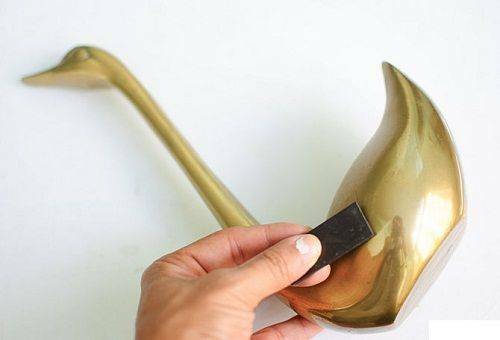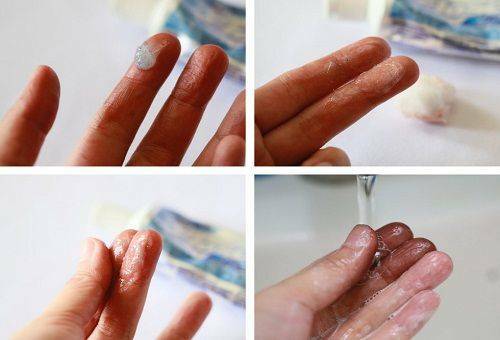
- What is gold?
- By the method of the medieval alchemists
- Nuclear chemistry
- Science fiction
- Reverse process
- Experiments passed without a trace?
- Without radiation
- Amalgamation
- Cyanidation
- Regeneration method
- Can I work with gold at home?
Since the moment when gold became a symbol of well-being, people sought to take possession of it. Medieval alchemists tried to make this metal from cheaper and affordable. In the end, scientists have learned to convert one chemical element into another, but this does not mean that anyone can turn an aluminum spoon into gold. How to make gold and is it even possible? Let's try to figure it out.
to the contents ↑What is gold?
This metal is known since ancient times. In Latin, gold is called aurum, and in the periodic system of Mendeleev it is denoted by the symbol Au. Both Slavic and Latin names mean "yellow".
Masters who made gold jewelry, attracted excellent physical and chemical properties:
- softness;
- plasticity;
- relatively low chemical activity;
- availability in nature.
Important! Pure gold is a very soft metal, it is easy to process mechanically. He can take any form. Products made of gold were firstly forged. From it, you can forge sheets that are a fraction of a millimeter thick. But this metal melts at a fairly high temperature - more than 1064 ° C.By itself this element is quite volatile, it begins to evaporate even before boiling.
Jewelry is relatively rarely made of pure gold. As a rule, alloys are used:
- with copper;
- with silver;
- with platinum.
Important! Pure gold is often used in technology - for example, for the manufacture of radio components, microcircuits, etc. However, only 10% of the total amount of this metal goes to industry. All the rest is centralized reserves of ingots of chemically pure gold. Approximately half belong to the states, the rest to private owners of ingots and jewelry.

The main characteristics are also weight and density. In terms of density, gold ranks seventh among all metals, It is 19.32 g / cm³.Due to its high density, it is quite easy to extract this metal.
Gold is extracted in several ways:
- by washing;
- by amalgamation;
- by cyanidation.
Washing is based on the fact that when washing sand, lighter fractions are washed away, and heavy gold particles remain at the bottom. Amalgamation - gold mining with the help of mercury, with cyanidation there is a reaction with cyanides.
Important! Very toxic substances are used in amalgamation and cyanidation.
to content ↑By the method of medieval alchemists
Medieval experimenters tried to create gold from lead. Let's try to understand how they did it and why they did not work. The answer to the question of how gold is made, of course, will not give this method, but it will help to understand the properties of different chemical elements.
The medieval alchemists adhered to the principle of "like reaching for such."If they had an ingot of gold, a piece of lead had to be attracted to him and eventually change their properties. The alchemist would need:
- a gold bar weighing 1 kg;
- Lead ingot weighing 2 kg;
- tool for cutting metal( a modern alchemist can easily take a hacksaw).
Then the process occurred approximately like this. To do something noble( like getting a precious metal), a person should have pure thoughts and a pure heart. Therefore, the researcher prayed to those forces in which he believed, seeking to purify himself and become worthy of his goal.
If you have already tried this, you can continue:
- Put both ingots on a table next to each other.
- Imagine that before you - two absolutely identical material, and noble.
- To meditate so much that you yourself believe that lead is gold, and stop distinguishing ingots.
- Saw a piece of lead.
- Put a piece of gold to the cut.
- Imagine that the molecules of two ingots gradually merge, the particles of lead are transformed into gold particles.
You do not believe that you will succeed? This is because you already know a lot about the periodic system of Mendeleev, and about the properties of different metals, and about what substances are reacting with gold, and with which - no, and what happens in the end. But in the Middle Ages even the most enlightened people did not even know this, and if they had not tested their naive methods, there would not have been any serious scientific discoveries.
to content ↑Nuclear chemistry
The researchers from the last century dealing with nuclear chemistry adopted the baton from medieval scientists. And they learned how to get this metal from other chemical elements! The impossible became possible, but not for everyone. This process is expensive, dangerous and requires special equipment, so it does not give an answer to the question of how to make gold by oneself.
The method is based on the fact that in a nuclear reactor some chemical elements are transformed into others. For example, the production of plutonium from enriched uranium is quite common and has been used for almost half a century in almost all nuclear power plants. But other elements are capable of transformation. For example, nickel can be made of iron, and chlorine can be made from sulfur.
American physicists do not joke
For the first time gold was managed by American scientists to get the "atomic" way. This happened in 1947.Twelve years before, another American, Arthur Dempster, had discovered that there was only one stable isotope for gold. And in early 1940, Harvard physicists A. Scherr and K. Bainbridge announced the receipt of artificial gold. They were able to disperse the deuterons and send them to the lithium target.
Thus, we got a stream of fast neutrons, which, in turn, bombarded the core of mercury. As a result, gold isotopes were obtained, but they were extremely unstable, lived for several days, and eventually turned back into mercury, and radioactive.
Important! Only seven years later, an artificial microsilver was obtained, which is now in the museum of science and industry in Chicago. The yield of the precious metal was very low - 35 μg from 100 g mercury.

Let's talk about the isotopes
Of course, a successful American experiment does not at all indicate that you can take a jar of mercury and turn it into gold with the help of a magic wand and spells or even a self-made nuclear reactor. Nuclear physics does not work with conventional substances, but with isotopes, that is, with radioactive, often unstable, variations.
Mercury has seven isotopes, of which relatively stable - three. The only stable isotope of gold is Au-197.It can be obtained from mercury with the same index. Radioactive mercury emits beta rays, as a result of which the molecule loses its individual elements and in the end another substance is obtained.
This process:
- is extremely time-consuming;
- is very expensive.
- is not so much practical as scientific significance.
Important! This method has another significant drawback. You can not simply take and alloy individual isotopes in the ingot. They still need to be freed from a mixture of nuclides and other isotopes.
Other substances
Gold can be made from other elements. True, even in an ideally equipped laboratory, it is not always possible to succeed:
- is mostly isotopes extremely unstable;
- substances can be even more expensive than gold( for example, platinum).
Science fiction
In parallel with attempts to make gold from mercury, other experiments were also under way. For example, in 1913 Frederick Soddy suggested that a precious metal can be obtained from thallium. He also believed that medieval scientists were right and that lead can also be used. He also had an idea to try to turn mercury into gold - but at that time the experimental base was still rather weak.
Sci-fi writers have also dealt with this problem. In the late 30's, the option of obtaining a yellow metal from bismuth suggested in one of his novels Dauman. His characters used powerful X-ray radiation as an instrument, and in general, the science fiction writer was not so far from the truth. True, his heroes did as much gold as they wanted, causing an economic crisis as a result of the Great Geographical Discoveries, when flows of gold from South America simply poured into Europe.
Important! However, fantastic novels still caused a certain resonance. The scientists paid attention to bismuth, but came to the conclusion that this metal does not have stable isotopes.
to content ↑Reverse process
If mercury can be turned into gold, then the reverse process is also possible? Medieval scientists have been asked this problem. But they did not have any similar goals, nor knowledge. Frankly speaking, the task of obtaining ultrapure mercury at that time was not, and now such a metal is needed. The answer was received when ultra-precise measurement standards were needed.
to the contents ↑Experiments passed without a trace?
Of course, the production of artificial gold can not affect, for example, the precious metals market. But to say that there is no practical value for gold isotopes, it would be wrong. Such isotopes are used in medicine for the treatment of certain forms of cancer.
to content ↑Without radiation
Can gold be made from mercury without nuclear reaction? Alchemists, including modern ones, believe that this is possible. In their opinion, it looks something like this:
- Take the necessary amount of mercury.
- Pour it into a refractory vessel.
- Place the vessel on a fire.
- Boil mercury.
- Throw powder into it - as much as another alchemist, your teacher, who determined the composition of the powder.
- Next, a small amount of what you got, and throw it in 1000 ounces of mercury.
- Mercury should turn into a red powder.
- Take a little of this powder and throw again a thousand ounces of mercury.
- Do this until all of the mercury is turned into gold.
Important! The fact that someone has succeeded and made gold by conducting similar experiments is not known to science. The mercury vapor is extremely toxic, so the end of the story may turn out to be rather gloomy. At home, experiment is clearly not worth it. But there are industrial methods of producing gold using mercury without any beta bombing.
to content ↑Amalgamation of
This method is based on the fact that mercury can form alloys with different metals.
Option 1:
- A breed containing gold is crushed.
- All this is well wetted.
- A humidified, fine fraction is mixed with mercury.
- The mixture is placed in a jugless bowl where further grinding takes place.
- The resulting amalgam is removed from the sludge by washing.
- Mercury from amalgam is distilled - it can be used again.
Important! This is a very old way, it was known even before our era. Most often it was used in South America after Spain got colonies there.

Option 2
Method of external amalgamation:
- As in the first case, the gold-bearing rock is crushed.
- The rock is then passed through special concentrating sluices - they were lined with copper sheets covered with a layer of mercury.
Important! These methods are now used quite rarely, mainly where there is a breed with a high gold content. This is most often done in Africa.
to Contents ↑Cyanidation
Gold has the property of dissolving in hydrocyanic acid and solutions of its salts. This was used to develop the extraction method:
- . The rock was ground.
- Treat it with a weak solution of sodium cyanide( concentration from 0.03% to 0.3%).
- Sodium cyanaurate is formed.
- The obtained substance is treated with zinc dust or ion exchange resin.
At first this method was used in large factories. Then it changed - instead of vats began to use watertight grounds, where the ore was poured and soaked in solutions of salts of hydrocyanic acid. Cyanides seeped and took with them the atoms of gold, and then all this entered the sorption columns, where gold was deposited.
Important! This method of producing gold is applicable only where there are no sulphides in the ore with which the hydrocyanic acid salts react. If there are sulphides, the process becomes much more complicated.
to content ↑Regeneration method
It is based on the fact that solutions of gold salts are treated with a 10% solution of alkali:
- The solution heats up.
- Gold is deposited on an aluminum surface.
Can I work with gold at home?
Gold turnover in many countries is closely monitored. Not as meticulous as, for example, the market of diamonds or emeralds, but still. In fact, if you are not going to master the craft of a jeweler and get the appropriate license, you have the opportunity to work only with what you can absolutely legally buy in stores:
- gold powder;
- jewelery;
- radio parts.
Gold powder is used to make decorative and applied arts products - from broken earrings, you can make another piece of jewelry. As for the radio components, there is very little gold there. To do something from the "gold scrap", it is best to go to the jewelry shop. Gold melts heavily, and when making jewelry, other metals are added to it, making it even more refractory.
Important! If you're lucky and you found a gold bar, it all depends on where you are. In many countries, such findings should be reported to the state authorities, otherwise - serious troubles may arise. You can, of course, do something for yourself, but it will be problematic to sell such an ingot or product from it.
As you can see, making gold at home is almost impossible, and often this process is associated with a greater risk to one's health. Therefore, we advise you to discard the attempts of quick profit from the production of gold bars at home. And if you really want to experiment and conduct scientific experiments, it is better to do it in the conditions of specialized laboratories. But for this you will have to learn and once again learn to have the appropriate knowledge, opportunities, access and qualifications.



